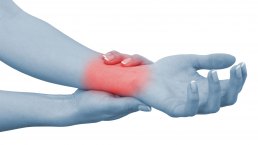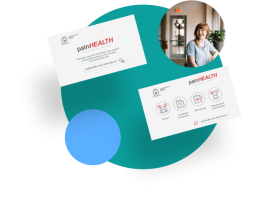Rheumatoid Arthritis
Learn about Rheumatoid Arthritis as a musculoskeletal pain condition to identify how you can treat Rheumatoid Arthritis to form a co-management plan
Last updated: 28 Oct 2023 · 6 min read
Rheumatoid arthritis (RA) is a chronic, systemic autoimmune disease that affects primarily the joints, typically the smaller joints in the hands and feet. Other joints such as shoulders, knees and neck can also be affected. RA is the most common auto-immune disease in Australia, affecting about 2% of the Australian population1. RA is the second most common arthritis after osteoarthritis (OA) and the most common type of inflammatory arthritis. The onset of RA usually occurs between the ages of 40 and 50 years. About three times more women than men are affected by RA.
RA is an auto-immune disease, which means that your body sees your own healthy tissue as something foreign and potentially a threat or a danger. The immune system then targets the lining of the joints, causing inflammation associated with joint pain and swelling, with the potential for joint and bone damage. Because RA is a systemic disease, it can also affect other body systems, such as your eyes, lungs and blood vessels. The cause of RA is unknown, however, there are contributory risk factors, including genetic factors such as a family history of RA, and environmental factors including smoking, gum disease, stress and obesity.
Early diagnosis and appropriate treatment can relieve symptoms, prevent or delay joint damage and ensure that people with RA can continue to lead an active life2.
What symptoms and signs suggest rheumatoid arthritis?
There are a number of symptoms that may suggest RA1. These vary from person to person and over the course of the disease. The most common symptoms of RA include:
- joint pain, swelling and stiffness usually affecting the wrists, fingers and toes on both sides. Other joints including the shoulders, elbows, knees, ankles and the neck may be affected
- pain that is typically worse after rest or early in the morning
- joint stiffness in the morning (>30 minutes) and stiffness after rest
- feeling generally unwell and losing weight
- reduced ability to do daily activities important to you including work, home and recreational interests
- skin lumps (nodules), eye dryness or redness
Fatigue or tiredness is very common in RA. You may find that resting more does not help this feeling. Sometimes trying to exercise in the hope you’ll improve may make the feeling worse and this can be disheartening. If you are in pain and feeling anxious, depressed, and not sleeping well, this feeling of fatigue can be very pronounced. You might find the pacing and goal setting or approaching pain management modules helpful.
If you suspect that you may have RA, we recommend you consult your doctor to discuss the potential for further investigations to diagnose RA and guide your management. Your doctor will arrange blood tests and possibly x-rays and other imaging. Based on these results, you may be referred to a specialist called a rheumatologist who will help guide you regarding further RA management.
Download our postcard
We've just created a postcard PDF you can download to share with your patients easily.
What happens when I am diagnosed with rheumatoid arthritis?
Diagnosing RA early and starting the right treatment at the right time will result in a better outcome. The rheumatologist will ask you about your symptoms, perform a thorough examination and request further investigations in order to make decisions about your diagnosis, management and the role of medications. He or she may also recommend visits to relevant health professionals (such as a rheumatology nurse, physiotherapist, occupational therapist, and podiatrist).
Nurses and physiotherapists play a large role in helping people with RA manage their disease symptoms and maintain participation in daily work, home and recreational activities. The rheumatology nurse can provide emotional support as well as giving you information on your disease, medications and RA support groups. The physiotherapist with skills in RA management can advise you about an appropriate exercise programme and activities to maintain joint function and muscle strength and to help manage pain. The occupational therapist can provide splints for inflamed or deformed hand joints and can advise you about aids to help you to function better as well as modifications at work and at home. The podiatrist can advise you on appropriate footwear and supportive insoles to relieve foot pain and prevent or support foot deformities. You may also find clinical psychology helpful especially if you experience low mood, persistent pain or have difficulties coping with your RA. You can check out the approaching pain management module: this gives you some practical tips for managing mood and access to some online training modules.
What about treatments?
If you do have RA, you need an individually developed treatment plan2. See our right care for RA fact sheet. Both pharmacological (medication)3 and non-pharmacological management approaches (for example, self-management including managing fatigue, joint health, stretching and exercising) are important4. There is good evidence that being educated about your RA, and working with your health team to develop a self-management plan including aerobic exercise (exercise that makes you ‘huff and puff’), muscle strengthening and stretching exercises that suit you, means better outcomes5,6,7. You might find the movement and pain management module, or pacing and goal setting activities such as yoga and mindfulness meditation may also be very beneficial in helping you manage your mental wellbeing.
You will need specific medications that slow the disease process3. These are known as disease-modifying anti-rheumatic drugs (DMARDs). These include conventional synthetic DMARDs (such as methotrexate), biologic DMARDs and targeted synthetic DMARDs (also known as small molecules). DMARDs are the mainstay of treatment for RA and are most effective when initiated early in the disease course3. There are some side effects and these are well documented, so you can discuss them with your doctor and refer to the Australian Rheumatology Association Medicine Information Sheets. Women who wish to become pregnant and/or breastfeed often need to modify their medications to optimise the health of their baby. In these circumstances, guidance from your rheumatologist is important. DMARDs control joint inflammation so that your symptoms of joint pain, swelling and stiffness improve. They also improve your functional ability and help prevent joint damage. Paracetamol and anti-inflammatory medications can improve joint pain and swelling, however, these do not slow the disease process.
What about symptom 'flares'?
There may be times when some of your symptoms are particularly bad – your joints may swell more, feel more painful and may be warm to the touch. This is known as a ‘flare’. There may be several reasons for this, including:
- the disease is progressing and your current medications are not adequate
- you may have had a busy weekend and over done things
- you had a recent infection, such as a cold or the ‘flu’
- you have been under stress and/or not sleeping well recently
It is important that you see your doctor or rheumatologist as early as possible. Your doctor or rheumatologist may need to adjust or change your medication(s). It is also important that you modify (not cease) your physical activity during a flare to allow your body to recover.
Further Information
For further information about RA go to Arthritis Australia. For more information about medications and RA, visit the Australian Rheumatology Association.
If you’re experiencing pain related to RA or are concerned about RA, we recommend our Medical Self-Check through our pain self-checks page to help you screen for conditions that may suggest you should consult a Health Professional. Alternatively, if you want to talk to someone about RA, please seek further assistance.
Movement with pain
Pacing and goal setting
Sleep and pain
Rheumatoid Arthritis: Promoting wise healthcare
Empowered - Arthritis Australia
Arthritis Australia - Rheumatoid Arthritis
Exercise and Rheumatoid Arthritis
Women's insight into Rheumatoid Arthritis
Rheumatoid Arthritis for physiotherapists e-learning
- Australian Institute of Health and Welfare. Rheumatoid arthritis [Link]. 2019 [cited 2019 Nov 23];
- Grigor C, Capell H, Stirling A, et al. Effect of a treatment strategy of tight control for rheumatoid arthritis (the TICORA study): a single-blind randomised controlled trial. Lancet 2004;364(9430):263-269. [PubMed]
- Smolen JS, Landewé R, Bijlsma J, et al. EULAR recommendations for the management of rheumatoid arthritis with synthetic and biological disease-modifying anti-rheumatic drugs: 2016 update. Ann Rheum Dis 2017;76:960-977. [PDF]
- Stoffer MA, Smolen JS, Woolf A, et al. Development of patient-centred standards of care for rheumatoid arthritis in Europe: the eumusc.net project. Ann Rheum Dis 2014;73(5):902-905. [PDF]
- Vermaak V, Briffa NK. Langlands B, et al.Evaluation of a disease specific rheumatoid arthritis self-management education program, a single group repeated measures study. BMC Musculoskelet Disord 2015;16: [PDF]
- Stenström CH, Minor MA. Evidence for the benefit of aerobic and strengthening exercise in rheumatoid arthritis. Arthritis Care Res 2003;49(3):428-34. [PDF]
- McQuade J, Mazur M (eds). A Practical Guide to Living with Rheumatoid Arthritis. Perth: Arthritis and Osteoporosis Western Australia. [Link]
This module was developed by Madelynn Chan, MBBS, MD, FRACP, FAMS, Senior Consultant Rheumatologist, Tan Tock Seng Hospital, Associate Professor, Lee Kong Chian School of Medicine, Nangyang Technological University, Singapore and Sonia Ranelli, PhD, MSc, BSc(Physiotherapy), Lecturer, School of Physiotherapy and Exercise Science, Curtin University, Perth, Australia.
The information in this module is based on current best evidence research and clinical practice.
SHARE THIS ARTICLE
Pain management information, stories and tips accessible anywhere, anytime.
Access clinically supported practical musculoskeletal pain management information to help you understand pain, how you can manage your pain with your management team on the go on any device.

